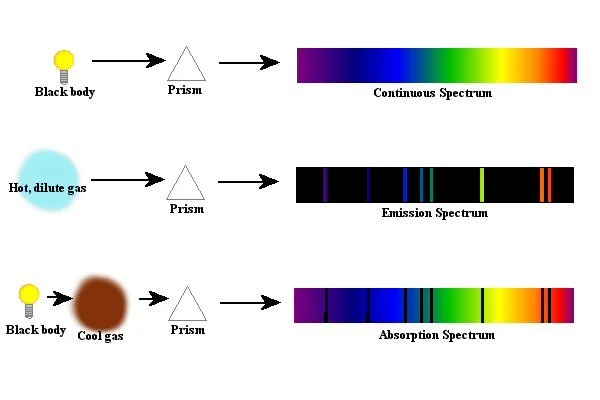The first signature of extraterrestrial life is likely to be the unnatural composition of gases in the atmosphere of a distant exoplanet. Think of the atmosphere as full of oxygen, and it is true only because it keeps on being replenished by plant and microbial life. If life disappears so would the oxygen. So if we see a distant planet with an atmosphere where the proportion of the gases is inexplicable by the laws of chemistry alone, like lots of oxygen or a mix of carbon dioxide and methane but little carbon monoxide, this would be a biosignature, a strong indicator that at least microbial life exists there. To confirm any large creatures, we just have to visit. But how do we know what chemicals the atmosphere of a distant planet contains? The answer is atomic spectroscopy. If we see a planet passing in front of its star, some of that starlight is absorbed in a particular pattern called an atomic absorption spectrum. Each element has a specific pattern like a barcode, so careful analysis of light can tell us which gases are in the atmosphere and their proportions. We already use this technique for stars and nebulae, measuring properties like temperature, density, ionization, and relative velocity. Think about how cool it is! We can look into deep space and get so much information from the light. It is like a gift that the laws of physics have given us and we have used it. Most of our knowledge of the universe comes from this technique. In this article, we will explore interesting facts about atomic spectra, understand the process behind this phenomenon and its applications, and finally, we will try to answer some of the frequently asked questions about the isothermal process.
Introduction:
The theory of quantum mechanics was developed from a set of mysteries in the late 1800s and early 1900s where reality didn’t match the models of physics at the time. We now call these older theories of physics, classical physics. There were several clues that pointed to some deeper model of reality. When light shines through a gas, the gas absorbs and emits specific frequencies of light which we call atomic spectra. This was a mystery.

There was no known classical explanation for this. And there was a lot of confusion about how atoms could be stable. In classical physics, the electron should continuously radiate its energy and collapse into the nucleus. The source of radioactivity was unknown. When you look at a hot body like the sun, it emits electromagnetic radiation in many different frequencies and this distribution is called black body radiation. Now the distribution from the black bodies didn’t match the prediction of classical physics. And when you shine a light on a certain metal, you can make an electron fly off, this is called the photoelectric effect. This experiment showed that the light didn’t behave like a wave, but like a stream of particles and it was the first indication of particle-wave duality. All of these mysteries can only be explained with the foundation of quantum mechanics.
Absorption and Emission Spectra:
Spectrum, in physics, is the intensity of light as it varies with wavelength or frequency. Spectra may be classified based on the nature of their origin as Absorption spectra or Emission spectra.
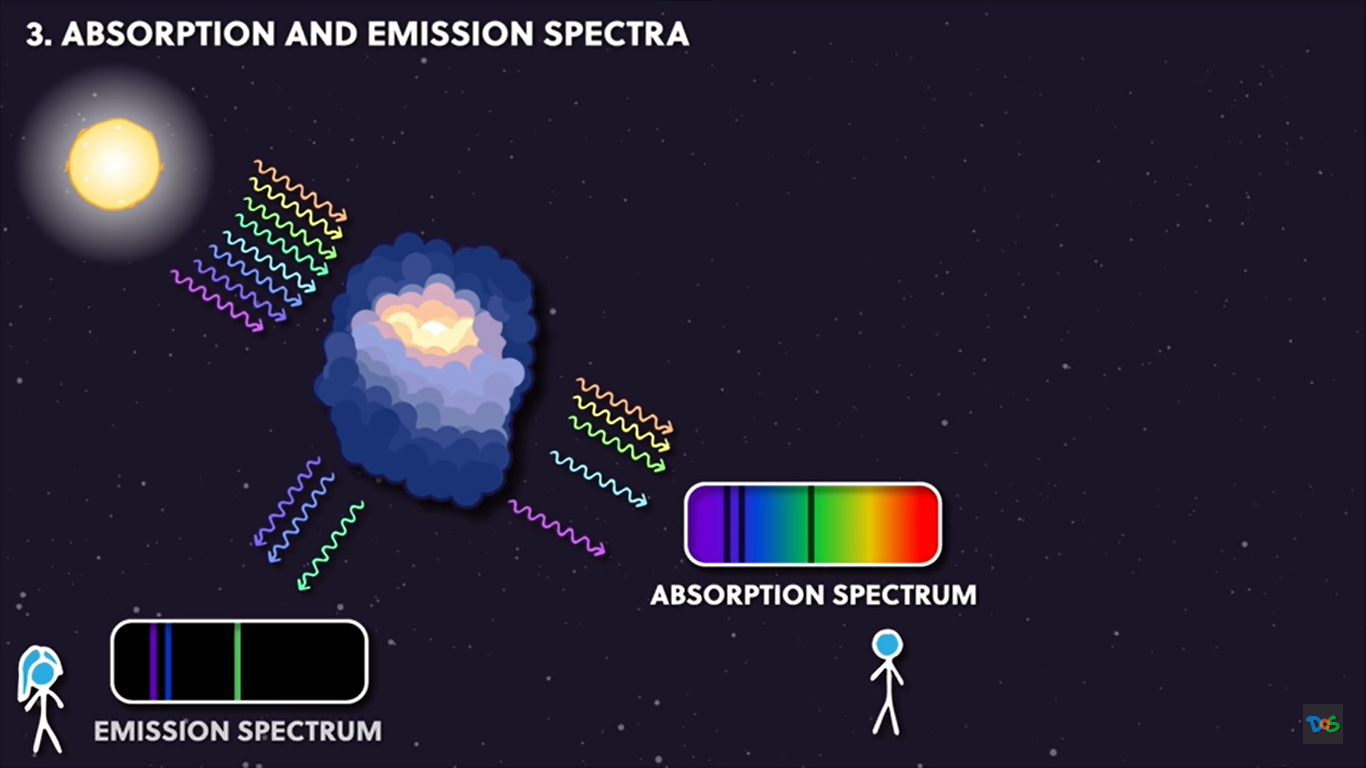
Absorption Spectra are where the light source is behind a gas and the gas absorbs and scatters certain wavelengths of light leaving dark lines in the spectrum of the star.
Emission Spectra are also produced by the same process but viewed from a different angle. Now you are only looking at the re-radiated light of the nebula.
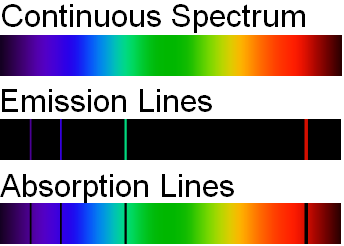
The spectrum of incandescent solids is considered to be continuous. In contrast, the spectrum of incandescent gases is known as a line spectrum since it only emits a small number of wavelengths. Due to the fact that a slit is being utilized as the light-imaging device, these wavelengths appear to be a collection of parallel lines. The elements that release radiation have line spectra that are distinctive to them. Since the lines depict the wavelengths that are emitted from atoms when electrons transition from one energy level to another, line spectra are also known as atomic spectra. Band spectra is the name given to groups of lines so closely spaced that each group appears to be a band—e.g., nitrogen spectrum. Band spectra, or molecular spectra, are produced by molecules radiating their rotational or vibrational energies, or both simultaneously.
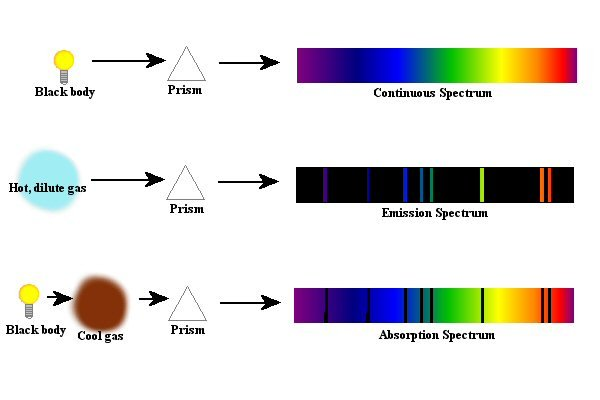
Electron Energy States of Hydrogen:
Why do we get these specific lines in atomic spectra? To answer this we need to delve into the world of quantum mechanics. Light is absorbed and emitted by the electrons in atoms and these electrons can only exist in certain energy states which are plotted for hydrogen look as shown in the figure below. The reason for these discrete energy states is that in quantum mechanics electrons are described by a wave called wavefunction, and this wave can vibrate only at a certain frequency in the constraint of the atom. It is just like a guitar string that only vibrates at a certain frequency in the constraint of being tied to the guitar. These waves are standing waves and each higher energy wave includes an extra half wavelength and oscillates at a frequency. Here the diagrams are simplified in one dimension but in reality, these are actually three-dimensional waves because the electron cloud is three-dimensional.
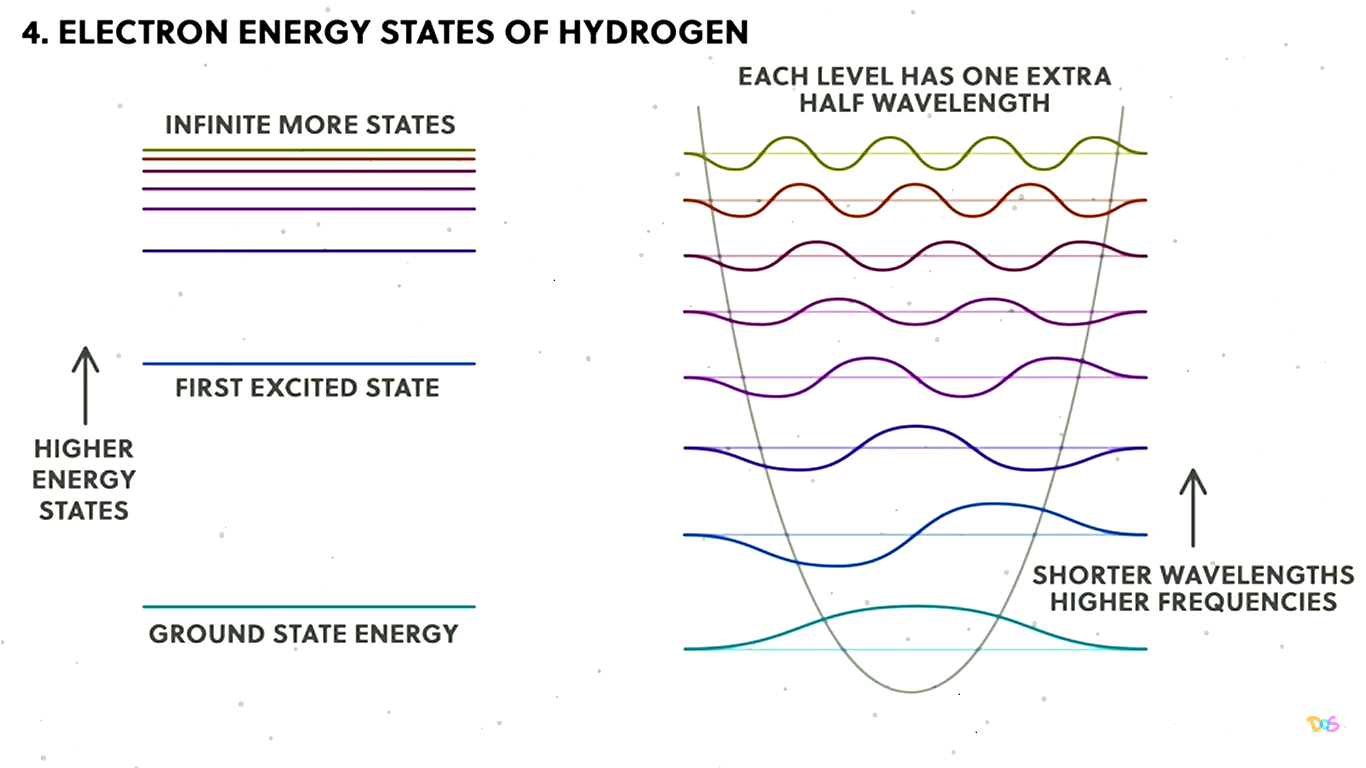
There are an infinite number of energy levels because you can keep on adding one more half wavelength to the electron wave, but the difference in energies between these levels gets smaller and smaller because the difference between the waves gets smaller and smaller. The biggest difference in energy is between the ground state and the first excited state.
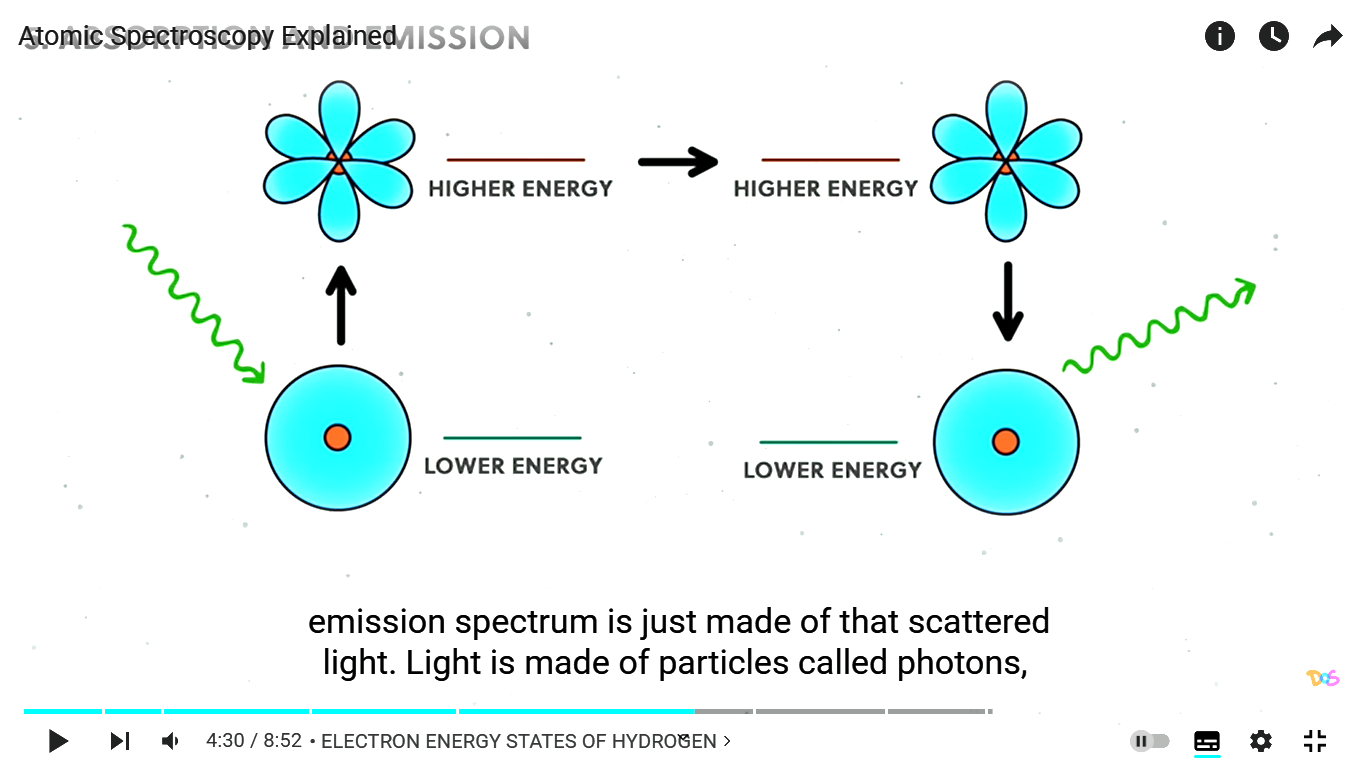
When light shines on the atoms, if it contains light with the same energy as one of the distances between the energy levels of the electron it can absorb that light and the electron jumps to a higher energy. Then it will later jump back to the lowest energy emitting the light in a random direction. This is why see the dark bands in the absorption spectrum because the electrons are absorbing light and then scattering it mostly in a different direction from the original light. So it is taking out those frequencies of the light. And an emission spectrum is just made that scattered light. Light is made of particles called photons and the energy of the photon is based solely on its frequency which you can see from this equation.
Where h is Plank’s constant and f is frequency.
Also, the frequency and wavelength are related to each other inversely by this equation, where c is the speed of light in a vacuum.
Here we have part of the emission spectrum for hydrogen. You’ll notice that there are three groups of spectral lines.
![]() There is a good reason for this. The first group called the Laymann group is made from all the decay from higher energy states down to the ground state. The other groups come from above down to higher energy levels in a similar way. That’s why the lines are grouped like this. Note that this is not to scale, in reality, these lines are far more spread out in the wavelength scale. And there are more series at longer wavelengths. You should also note that here Hydrogen is considered as an example because it has only got one proton and one electron so it has got relatively simple spectrum. But the spectra of other elements are more complex and a real observation of many many different gases overlapping is incredibly complex.
There is a good reason for this. The first group called the Laymann group is made from all the decay from higher energy states down to the ground state. The other groups come from above down to higher energy levels in a similar way. That’s why the lines are grouped like this. Note that this is not to scale, in reality, these lines are far more spread out in the wavelength scale. And there are more series at longer wavelengths. You should also note that here Hydrogen is considered as an example because it has only got one proton and one electron so it has got relatively simple spectrum. But the spectra of other elements are more complex and a real observation of many many different gases overlapping is incredibly complex.
Fine structures and Hyperfine structures:
Now you know the basic of Atomic Spectra. But it’s worth knowing about the fine structure and hyperfine structure. These are where, if you look at a spectral line really closely you’ll see that they are often made of two or more spectral lines that are incredibly close together. 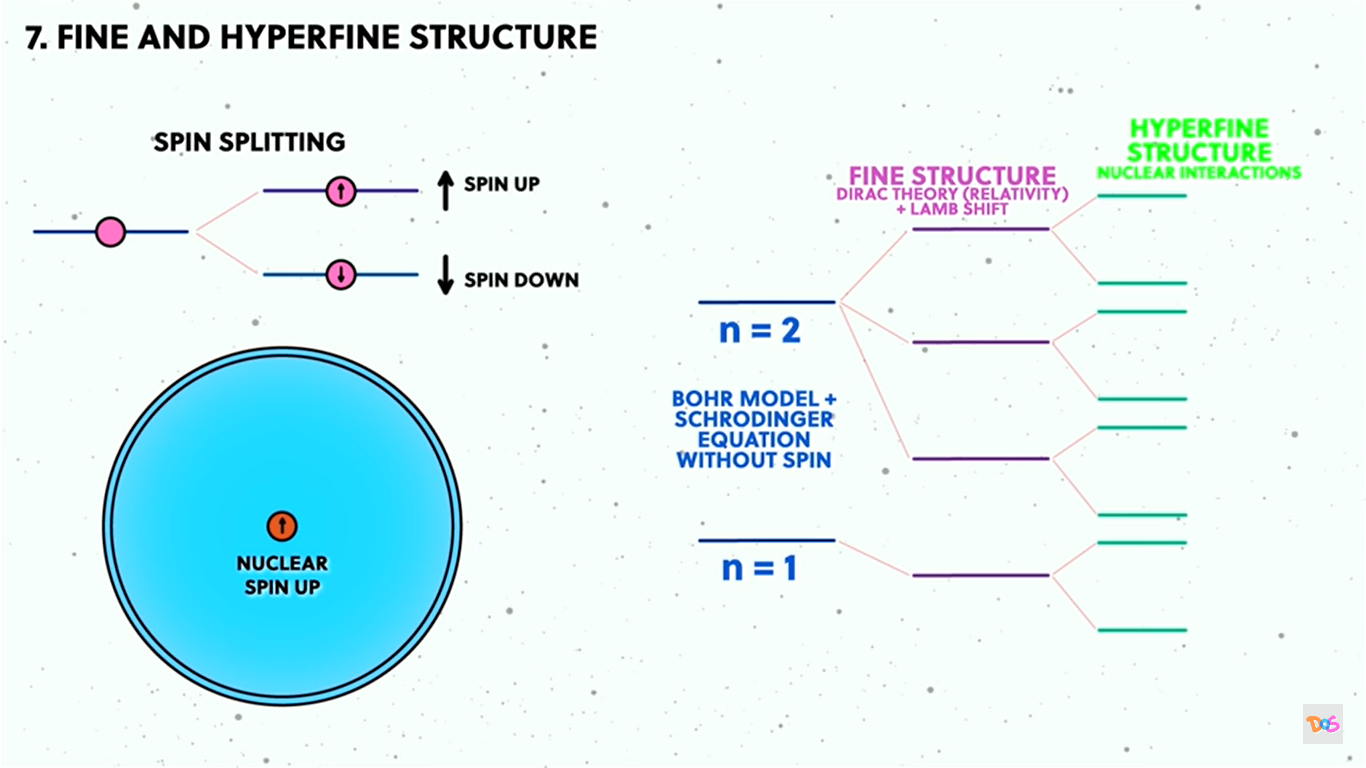
The atomic spectra we have talked about so far are an idealized model, but when we add in the spin of the electron and also relativistic effects we get the fine structure splitting of the energy levels. And beyond that, the hyperfine structure is seen as small shifts and splitting of these energy levels caused by interaction between the electrons and the nucleus through their mutual magnetic or electric fields as well as other effects.
Other ways light and matter interact:
Now it is important to note that whatever we have discussed so far isn’t the only way that light interacts with matter. There are a few other ways that you should know about. The most common is scattering which happens when are free to wiggle about when light shines on them called Rayleigh scattering. We don’t need the rules of quantum physics to describe this. It is a classical effect of light being a vibrating electromagnetic wave that interacts with the electric charge of the electrons causing them to wobble and then become an oscillating source of more electromagnetic waves that radiate out in all directions. This scattering called
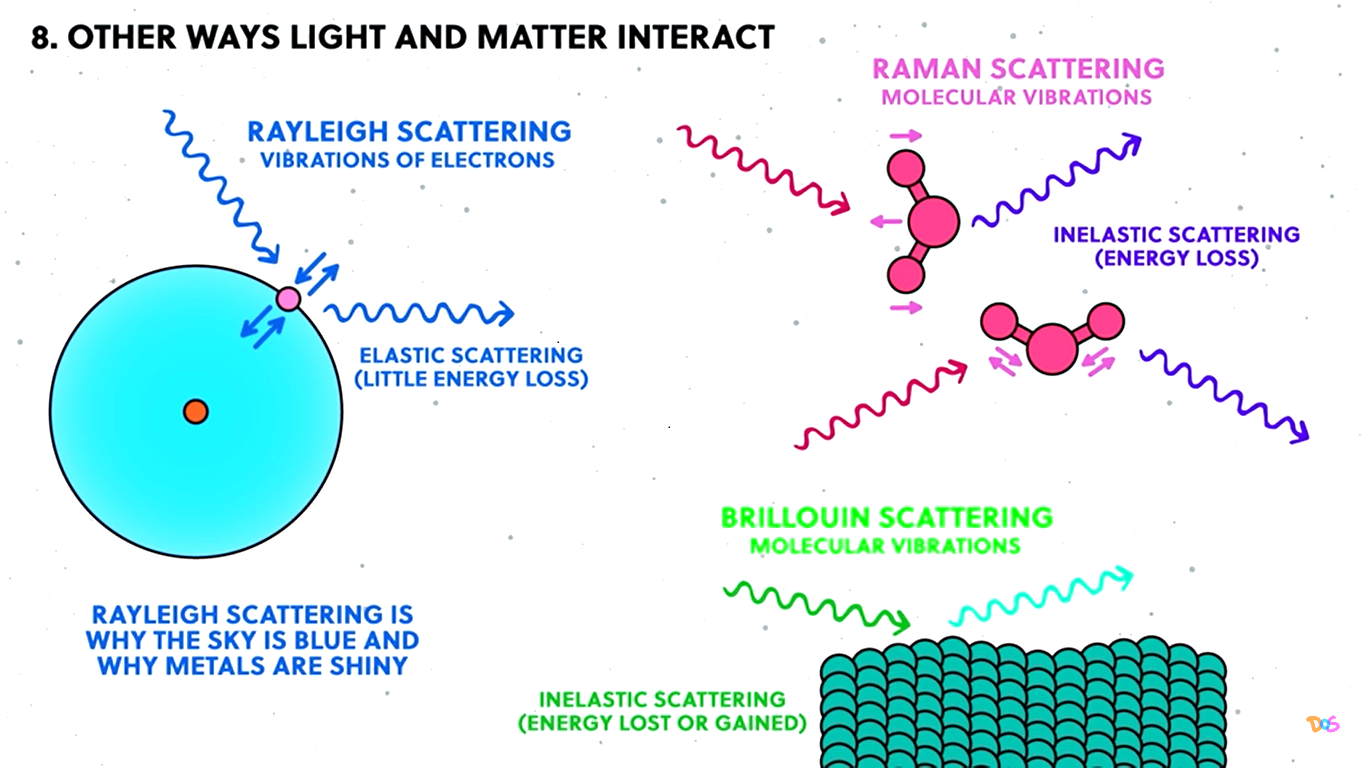
Rayleigh’s scattering is what causes the blue colour of the sky and the red colour of the sunset. It is also why metals are sol reflective because they have lots of free electrons that move around easily. We have also got Raman scattering when light shines on molecules in different modes and has its own spectroscopy called Raman spectroscopy. There is also Brillouin scattering where light can lose or gain energy when interacting with vibrational waves in the atomic lattice of solids.
Applications of Atomic Spectra:
A few of the important applications of Atomic spectra are listed below.
- In astrophysics to for probing the composition of space objects.
- To determine the composition of the atmosphere of the exoplanets
- To estimate Redshifts of the distant space objects
- In chemical spectroscopy, to see what elements and compounds are made of. This is used to see what a sample is made of.
- Using hyperfine structure to delve into the nucleus with nuclear magnetic resonance and other techniques.
- In producing lasers. Lasers come from controlling the emission from specific energy levels.
- In Atomic clocks. Atomic clocks need is a standard oscillator to keep the same time. So using light from the specific hyperfine transition of the Cessium-133 atom which is also how the SI unit of distance the meter and time the second is defined. And this also sets the definition of the speed of light.
Recommended Articles:
Astigmatism Eye Defects: Causes, Types And Correction
Atmosphere: Definition, Layers and Significance
Atmospheric Pressure and Gauge Pressure
Read all about Atomic Number Mass Number
Atomic Radii: Introduction, States and Variation
Atomic spectra are defined as the spectrum of frequency of electromagnetic radiation that is absorbed or emitted by the element or compound when a stream of light strikes it. Atomic spectroscopy is the study of electromagnetic radiation that is emitted or absorbed by atoms. The spectrum produced by hot solids is called the continuous spectrum. The spectrum produced by hot gases is called the emission Spectrum. The spectrum produced by cold gases is called the absorption Spectrum. Vegetables Names FAQs
What are atomic spectra?
What is atomic spectroscopy?
What is a continuous spectrum?
What is the emission spectrum?
What is the absorption spectrum?
